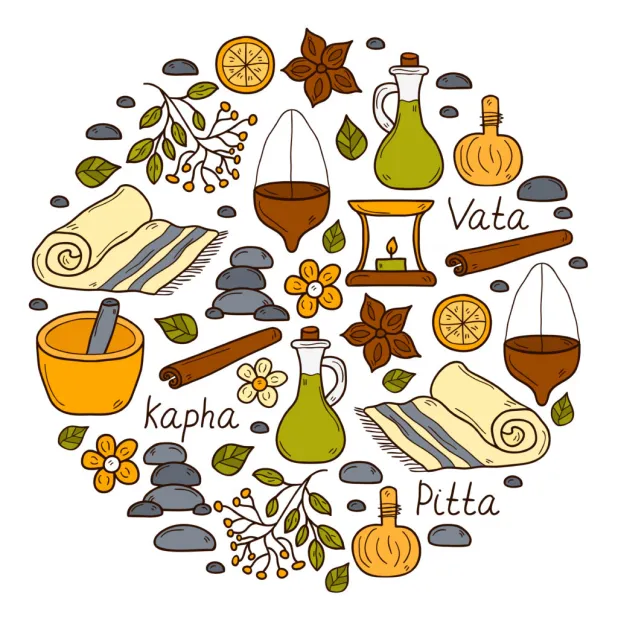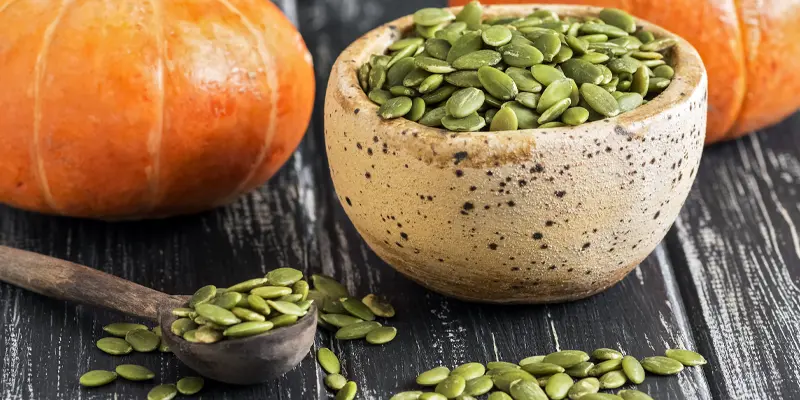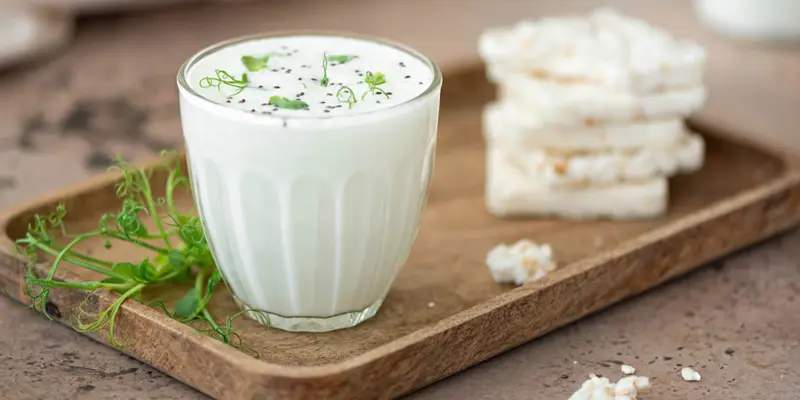Here we’ll discuss a Pitta Kapha pacifying diet along with a sample menu and Ayurveda-approved recipes for Pitta-Kapha individuals. Pitta-dominated Pitta Kapha prakriti (Pitta Kapha body type) has a unique advantage. If the two doshas work complementary to each other and remain in balance, then they have a good metabolism.
That metabolism is fueled by primary Pitta Dosha and a well-nourished body, which is a characteristic of secondary Kapha dosha.
But these two doshas have certain antagonizing properties which will pose a challenge to you in catering to these two doshas at the same time.
The primary fiery Pitta being dominated by the fire and the water element antagonizes the earthy Kapha dosha dominated by the earth and water element.
You might question how the antagonizing elements of fire and water can coexist in Pitta.
Well, the property of water which is represented in Pitta is fluidity. This provides the necessary ability to flow to the substances that represent Pitta in the human body, like enzymes and hydrochloric acid of the stomach.
On the other hand, the water represented in the Kapha bestows predominantly cold, cohesive, and smooth qualities to Kapha. Overall Kapha is always a threat to the fiery nature of Pitta.
So how do you balance the Pitta Kapha constitution?
Being a Pitta Kapha type, you need to always keep an eye on the food you ingest.
You don’t want to increase the Kapha levels in the body to the point where they dampen the fiery nature of Pitta and thereby the digestive fire or agni that is nurtured by Pitta.
On the other hand, it would not be in the best interest to let the fiery Pitta turn into a ‘blazing fire’ so that it ‘dries’ up all the lubrication, cohesiveness, fluidity, coldness, and earthiness of Kapha.
You may be aware that Ayurveda gives equal importance to diet and lifestyle as it gives to herbal therapy. So it is very important that you know what to eat and what to avoid to keep your two constituent doshas in mind.
You probably have many questions about eating for these two doshas. Should you always have Pitta-pacifying foods or should you have a combination of Pitta-pacifying and Kapha-pacifying foods?
Is it always necessary to have pacifying foods or one may also have foods that are akin in property to the constituent dosha? Which meal should be the largest meal? Should you have cold foods like ice cream? Which grains are best for Pitta Kapha?

Pitta Kapha Diet And Acid/Alkaline Balance

The Kapha, if in balance, provides a cradle for the digestive enzymes and juices to act properly in the stomach and small intestine. It also provides lubrication to the stools to be moved properly (by the action of Vata) in the intestines.
Throughout the body, it counters the acidic environment created by Pitta-dominated metabolites and provides the buffering alkaline environment.
Thus a properly balanced Pitta and Kapha is necessary for the proper acid-base balance which is an important contributor to the proper functioning of the body.
If Pitta becomes aggravated, it tilts the balance towards an acidic state and depletes Kapha and its protective actions, as indicated above, causing various kinds of excoriating and inflammatory disorders and disorders related to blood.
Conversely, if Kapha gets stronger (through an increase in its properties) then it shifts the balance first to the alkaline side.
The digestive fire (agni) is believed to ‘fuel’ the so-called ‘metabolic fires’
But as it becomes aggravated further, it antagonizes the digestive fire and dampens it and as such, the metabolism all over the body is hampered.
The reason is that the digestive fire is believed to ‘fuel’ the so-called ‘metabolic fires’ which are referred to as bhootagni and dhatwagni.
So a weak digestive fire leads to the formation of many unwanted metabolites that in turn lead to the precipitation of many chronic disorders.
So, as your physiology is dominated by these two doshas both important for metabolism, growth, and repair, you need to take care that your diet fulfills the requirements of the two, does not aggravate either of them, and keeps them both in balance.
There are no absolute must-avoid lists for a Pitta Kapha diet, but definitely, there are foods that are more likely to suit Pitta Kapha over others. The other less suitable ones should be taken less frequently.
How To Follow A Pitta Kapha Diet

Having a dual Prakriti, you need to listen to your body. The dosha that is aggravated or depleted will need your attention. Pitta dosha symptoms are different than Vata dosha symptoms and Kapha dosha symptoms.1
So when a dosha is aggravated, use foods that have properties opposite to that of the dosha in question.
On the other hand, if your body gives symptoms that point towards the depletion of a dosha, use foods with the same properties as that of the particular dosha.
However, if both of your constituent doshas are in equilibrium, you need to follow certain guidelines that will keep the two in the desired state of balance. These guidelines will come in handy when you’re choosing a meal plan.
- You should take care to eat moderate quantities of well-cooked food at regular intervals, breakfast, lunch, and dinner. Snack on fruits, steamed or sautéed sprouts, or a small serving of cereal in the mid-morning and late afternoon. Lunch should be the largest meal of the day with a very light breakfast and a lighter than lunch dinner. An early dinner by 7-8 pm is recommended.
- You should sit peacefully and eat in a calm place. Chew the food properly and eat slowly. Eating while walking, working, and talking or in an angry state of mind, is likely to cause acidity and indigestion, which the Pitta Kapha person is prone to.
- Liquids should be taken an hour before or an hour after meals, so as not to dilute the digestive juices. A few sips in between, however, may be taken.
- Since Pitta is hot by nature and Kapha is cold it is advisable to consume warm, cooked food that is cold by nature like watery vegetable zucchini, squash, melons, gourds, and grains like quinoa, barley, whole wheat, wild rice, and oats with bran. This will pacify the Pitta and Kapha. Raw salads can be good in warm weather but could aggravate Kapha (and also Vata) if taken in cold weather. During that time soups and steamed vegetables can be taken instead.
- Barley, in particular, is very good for balancing Pitta and Kapha keeps cholesterol and blood sugar in check (which a Pitta Kapha person is prone to), and also checks sweet cravings. Hence it is highly recommended. Other sources of carbohydrates could be wild rice, oats with bran, and quinoa.
- Fats like soybean oil and olive oil are good for you as they balance Pitta and do not aggravate Kapha if taken in small quantities. Ghee may also be used in small quantities. Total fat intake may be restricted to 4-6 teaspoons per day in view of the secondary dosha Kapha.
- Egg whites, suitable meats, and milk or milk substitutes like almond milk or soy milk are recommended sources of proteins. Proteins may be procured from vegetable sources like moong beans if you wish to avoid animal proteins. Using vegetable proteins like moong beans, in place of animal proteins like red meat and fish can be effective in balancing Pitta. Fish and whole eggs are Pitta aggravating but can be taken sparingly. The rest of the time, take vegetable proteins. Adequately cooked sprouted or un-sprouted beans and grams taken as a meal with vegetables can also be beneficial to pacify Pitta and Kapha. If you have signs of Vata aggravation, by any chance, like flatulence or body pains, then the grams and sprouts are to be avoided and only green moong dal and pink or yellow lentils can be taken after cooking them in ghee or olive oil along with spices like cumin, garlic and a pinch of asafoetida.
- Most of the vegetables that are not too starchy or ‘hot’ in the property are good for Pitta Kapha. Nightshades are Pitta aggravating so should be avoided. Instead, vegetables like gourds, zucchini, squashes, celery, leafy greens (except mustard greens), and green beans can be taken liberally. Too many root vegetables and potatoes are Kapha aggravating and also aggravate Vata and hence should be used sparingly. Salad leaves can be taken in peak summers as cool (not cold) salads but should be replaced by cooked vegetables in other seasons.
- Yogurt is best avoided as it aggravates both Pitta and Kapha. Low-fat fresh buttermilk can be used instead during the daytime to replenish gut flora (lactobacilli). Add ½ tsp of roasted cumin powder and a little rock salt to a glass of buttermilk. This has beneficial effects on overall health and has properties different from milk and other milk products like cheese and yogurt. It is thus recommended.
- Fruits like apples and pears which are neither very sweet nor sour can be taken. Too sour and too sweet fruits should be avoided. Fruits, sprouts, and lightly roasted seeds like pumpkin and sunflower are excellent snacks in between meals.
- Use spices like fennel, coriander, garlic, curry leaves, mint, cumin, turmeric, and fenugreek seeds. The fenugreek seeds and turmeric need to be used in small quantities as they have hot properties. But as they are bitter also they will not aggravate Pitta and will pacify Kapha when used in the right proportions. If Kapha is aggravated (marked by mucus production, a white coating on the tongue, loss of appetite, and lethargy) then spices like black and long peppers and fresh ginger can be used for a short period until Kapha comes back into balance.
- As per the constituent doshas, Pitta and Kapha, the use of bitter and astringent tastes pacifies both Pitta and Kapha. So bitters like bitter gourd, mint, curry, and fenugreek leaves (and seeds) and astringents like salad leaves (following the guidelines given earlier) and spinach, are vital to a healthy diet.
- Chew upon 1 tablespoon of fennel seeds along with a few crystals of sugar candy after lunch and dinner. This can be good to balance stomach acid and aid digestion.
- Avoid alcohol, too much tea, coffee, and cold beverages. Cooling drinks like sherbets and herbal teas can be taken in hot seasons. Water is the best beverage to have and should be taken in adequate amounts according to the thirst and hydration levels.
READ MORE: Indian Spiced Buttermilk Recipe For Strong Digestion | Pitta Cooling Foods And Drinks For Summer + Infographic
Sample Menu Plan For Pitta Kapha Types
Early Morning

Start your day with 10 raisins and 10 almonds that have been soaked overnight in water. This should be followed by an apple/pear and a coriander tea.
For coriander tea, take 1 teaspoon of coarsely ground coriander seeds and boil in one glass of water, reducing to half. Strain and drink lukewarm. Take this 2 times during the day. This will keep Pitta and Kapha in equilibrium.
Breakfast

Take a suitable breakfast cereal like oats with bran cooked in skim milk or a milk substitute. You may have boiled pearled barley with a dressing of honey as well.
Complete the breakfast with a glass of coconut or soy milk. Alternatively, have a sandwich of yeast-free whole wheat bread (with bran) with 2 egg whites and a side of sautéed Moong beans and cooked vegetables.
You may have a cup of mint and tulsi tea along with it.
Midmorning

Have a handful of roasted pumpkin seeds and a piece of fruit.
Lunch

Lunch can include a glass of buttermilk as a starter. The main course can be composed of cooked grains like pearled barley or quinoa along with vegetable or animal proteins and vegetables.
Evening

Have coriander tea along with a fruit salad sprinkled with some roasted seeds or a small bowl of boiled beans appropriately seasoned with spices and salt.
Dinner

Dinner could be the same as lunch but can include soups as starters, particularly in the winter season. It should be lighter than lunch.
After Dinner

You may have a cup of milk or soy milk boiled with a pinch of turmeric and a pinch of cardamom powder before bed.
Please consult a qualified Ayurvedic practitioner before trying the dietary recommendations mentioned in this article.
FREQUENTLY ASKED QUESTIONS
What foods should be avoided on a Pitta diet?
To balance Pitta, it’s best to avoid foods that are sour, salty, and spicy. Specifically, steer clear of tomatoes, radishes, chilies, garlic, and raw onions. Also, limit excessive intake of meat, eggs, overly salty foods, coffee, alcohol, tobacco, and even too many nuts.
What are the physical and emotional symptoms of a Pitta dosha imbalance?
When Pitta is out of balance, physically you might experience inflammation, skin rashes, acidity, heartburn, ulcers, and excessive body heat. Emotionally, signs include irritability, anger, impatience, perfectionism, and a tendency to be overly critical.
How to determine if you have a Pitta dosha imbalance?
Notice how your body and mind feel. If you often feel overheated, experience skin breakouts, acid reflux, or digestive discomfort, or if you find yourself easily angered, frustrated, or pushing yourself too hard, these can be clues that Pitta is imbalanced. Listening to both your physical symptoms and emotional patterns can help you spot an imbalance early.
What are some personality traits associated with a Pitta dosha?
Pittas are natural leaders — ambitious, focused, and driven. They tend to be intelligent, determined, and passionate but can also lean toward being intense, competitive, and at times a little impatient or critical if not balanced.
What are the five elements of nature in Ayurveda and how do they relate to the human body?
Ayurveda teaches that everything in nature, including us, is made up of five elements:
● Space (Ether) – Represents openness, communication, and the subtle aspects of bodily functions.
● Air – Controls movement, breathing, and muscle function.
● Fire – Governs metabolism, digestion, and transformation in the body and mind.
● Water – Involves circulation, fluid balance, and emotional flow.
● Earth – Provides structure, stability, and endurance to the body.
Each dosha (Vata, Pitta, Kapha) is a unique combination of these elements. Pitta, for example, is mainly fire with a little water.
How to balance Pitta dosha through diet?
Choose cooling, hydrating, and soothing foods. Focus on sweet, bitter, and astringent tastes. Some ways to balance Pitta include:
● Avoid spicy, sour, and salty foods.
● Embrace cooling spices like fennel, cumin, and cardamom.











Very useful dietary advice for healthy living
The starter of almonds and that too of 10, I totally deny
That’s not useful for pitta dominating body.
As far as of heavy nuts and dry fruits, thay are not much of use for this body type.
Raisins is good yet seeds like pumpkin seeds and melon seeds are the best . One tbs powder of all dryfrits along with these seeds is the better option added in skimmed milk or warm water. 1tbss Jaguary or and honey added in it is optional and is healthy too…